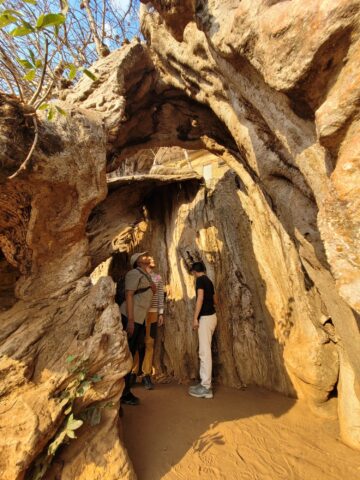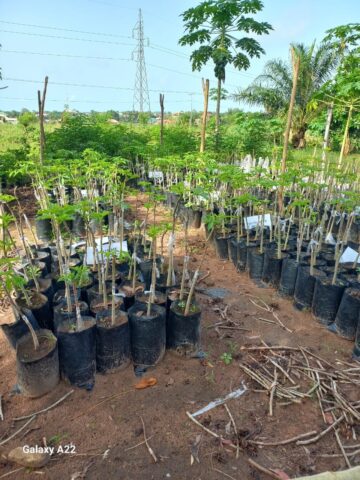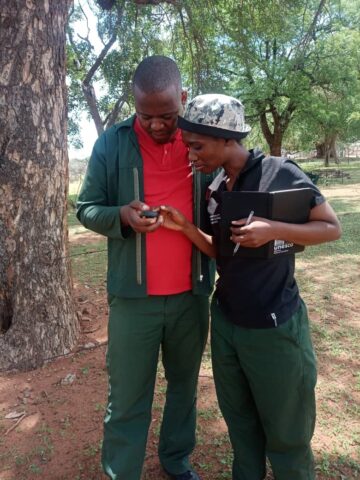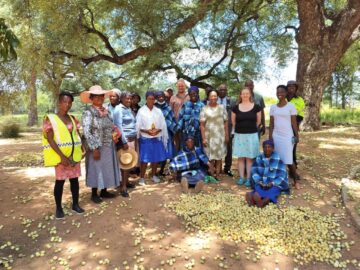Projects
This page lists the diverse activities carried out within the Baorula network.
The book: Baobab and Marula: New Solutions to Global Warming and Food Security
The BAORULA Network has compiled a scientific book targeted for the larger audience. Baobab & Marula: New Solutions to Global Warming and Food Security introduces a whole spectrum of possibilities related to these two African trees. The book was published in September, 2025, and it can be purchased via the website of Into Publishing.
Legislators' Guide to Carbon Credits and Carbon Sequestration
The climate conference in Paris in November 2015 created a global framework for the global trade with carbon credits, or the trade with carbon absorption and sequestration services. Sub-Saharan Africa would be especially well placed for benefitting from this framework: it has an exceptional collection of trees that cannot burn in forest fires, that are immune to insects and plant disease, that cannot be felled by storms, that can become very large even in arid and semi-arid conditions — and that are very popular among rural people because they are also producing large crops of nutritious food. In spite of this, at the beginning of 2024 none of the governments in the Sub-Saharan countries had enacted legislations that would enable the selling of carbon credits (or carbon sequestration services) for the international markets. This led the BAORULA Network to start preparing a book highlighting the possibilities, potential and problems of the carbon credit trade. The purpose of the book is to catalyze the preparation of national legislations related to the trade with carbon credits, while also influencing the process in a way that most of the income from carbon trading would be channeled to local communities and state governments. If the profits flow to oligarchs and foreign corporations, the carbon storage in African trees will not be safe nor can the programs play a constructive role in preventing a global climate catastrophe. The preparation of the Legislators’ Guide is sponsored by Atmosmare Foundation. We will launch a survey on the topic in January 2025.
Pedagogies of Biodiversity and Environmental Sustainability (PEBES) (2022-2024)
PEBES is an education development project between The University of Turku (Finland), Botswana University of Agriculture and Natural Resources, University of Namibia (2022-23) and Humak University of Applied Sciences (Finland). It is funded by the Team Finland Knowledge Programme of The Finnish Agency for Education during 2022-2024. The project offers staff and students of the participating universities a dive into interdisciplinary topics and as well as mobility courses under the theme of biodiversity, education and management of natural resources.
The themes of the four mobilities were (1) Sustainable Seas, hosted by University of Turku in Finland in 2023, (2) Chobe Enclave Conservation Trust Student Outreach, hosted by Botswana University of Agriculture and Natural Resources (BUAN) in Botswana in 2023, (3) Outdoor Adventure Education for Promoting Sustainable Future and Environmental Education, hosted by Humak University of Applied Sciences in Finland in 2024, and (4) Enabling Communities to Sustainably Care for Natural Resources, hosted by BUAN in Botswana in 2024.

The mobility team of 2024 was marvelled by an old Baobab tree which had in old times served as a prison in northern Botswana. Photo: Henna Rouhiainen.
The Baobab Model Farm (2025- )
The BAORULA Network supports, together with the Atmosmare Foundation, the Baobab Model Farm project at Ho Technical University in Ghana. The main goal of the project is to show that growing baobab trees can be a most attractive option for African small farmers, due to the income from baobab fruit and leaves and, possibly, from the financial compensations for the carbon dioxide the trees are absorbing from the atmosphere.

Marula Tree Mapping in Botswana (2024-2025)
The development of Botswana’s marula fruit industry has reached a stage where it must show that it has enough of a resource to warrant a serious investment, and/or that it has plans to increase and improve its marula resource base. This project is undertaken by the Ministry of Local Government and Traditional Affairs (LDTA) which its main mandate is to support rural development in the country. The ministry has therefore partnered with Botswana University of Agriculture (BUAN) in mapping marula resource base in selected districts in Botswana: Tswapong (eastern), north eastern and Nata Gweta areas. The marula resource survey aims to address the question whether a commercially viable resource is available. The main aim of the marula tree mapping is to establish whether enough amounts of marula fruits are available to justify the development of further commercial opportunities around this resource, especially in rural areas.
Without additional investments in chemical analyses and the development of processing methods, this resource survey information alone will not guarantee advancement of marula fruit commercialisation. However, just knowing with some degree of certainty how much marula is (or can be) available for processing is an essential piece of the puzzle, regardless of when the technical work is done and how it is funded. Hence this study’s intervention will contribute to improving the long-term management of Botswana’s marula resource and open up new commercial opportunities for marula producers by improving knowledge management around the resource, institutionalizing support to marula harvesters and growers, and building national capacity to propagate and cultivate marula.
The objectives of the assignment include (1) conducting a natural resource mapping for Sclerocarya birrea (Morula) in the Tswapong, North-east and Nata-Gweta areas, (2) examining the current population structure of the marula tree in the northern part of Botswana, (3) studying the regeneration and recruitment of marula seedlings and to compare the population structure of the marula trees in the different landscapes and hence the different sub-strata of the population and distribution of Sclerocarya birrea, (4) assessing socio-economic benefits of Sclerocarya birrea (micro space economic approach – value chain addition), and (5) identifying other veldt products apart from morula that local communities are already tapping on for income generation and those with the potential in the identified districts.
The project is led by Prof. Joyce Lepetu and the other team members are Prof. Melusi Rampart, Mr Ishmael Kopong, Mr Topoyame Makoi and Ms Gofaone Rammotokara.

Mapping Marula with GPS. Photo: Joyce Lepetu.

Visitors from BUAN and UTU participated a Kgotla meeting in Matlhako in January, 2025.
Erasmus+ networking between Botswana, Ghana, Namibia and Finland (2023- )
The European Union’ Erasmus+ Programme has enabled development of collaboration among BAORULA partners through short term staff mobilities since 2023. The involved HEIs include the University of Turku (Finland), University of Namibia, Ho Technical University (Ghana) and Botswana University of Agriculture and Natural Resources.
One of results of these mobilities is a course on Food Innovation and Value Chain in Africa, produced jointly by the Ho Technical University and the University of Turku. The course explores the socio-economic and ecological significance of neglected and underutilized tree species (NUS) in Africa, with a special focus on baobab and marula.
Baobab Conservation and Fruit Sale Impacts on Rural Livelihood Assets in Ghana (2024-2025)
This study, conducted in 2024, examined the impacts of baobab conservation, fruit collection, and sale on livelihood assets using data from a forest deciduous zone in Ghana and the Propensity Score Matching approach. A mixed-methods approach of both quantitative and qualitative primary data collection was used, as well as a multi-stage sampling procedure. The target area of the study was the Adaklu District in the Volta Region of Eastern Ghana where farming activities are dominant and where there is a sizable Baobab tree population. A publication of the results is under preparation by Dr. Agbemavor Horlu, Prof. Egbadzor and Prof. Adefila. The study was financially supported by Staffordshire University (U.K.).